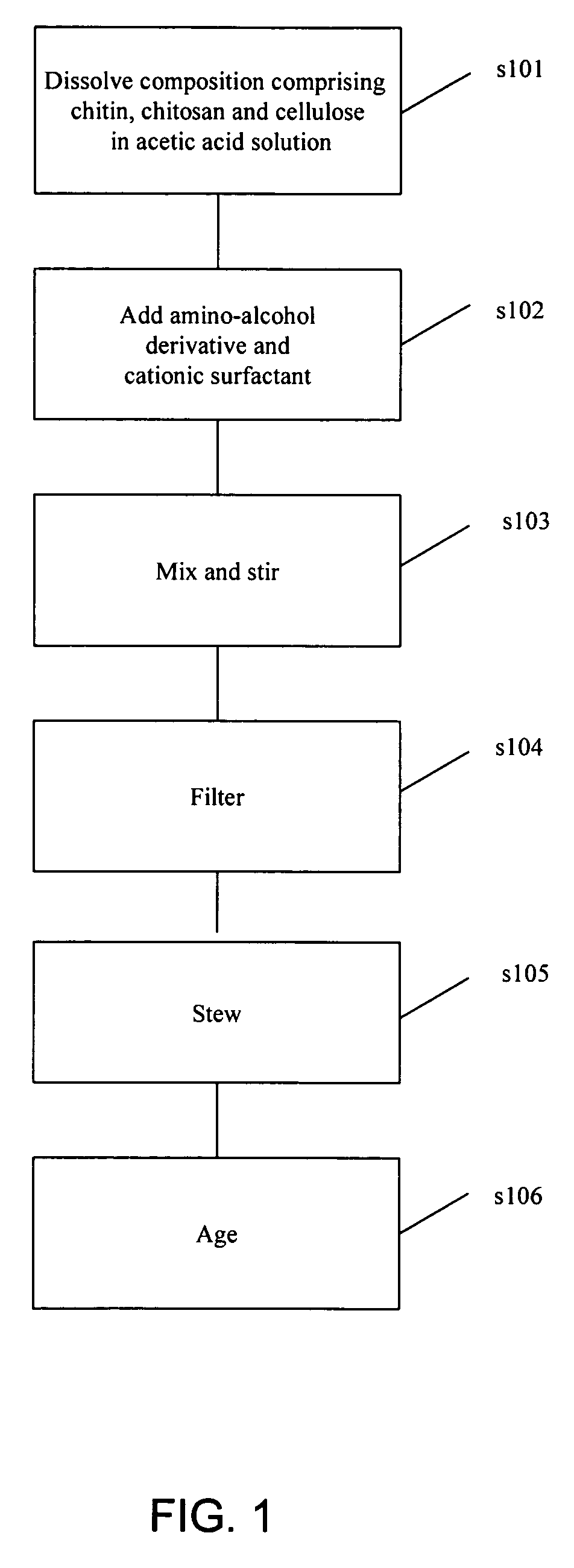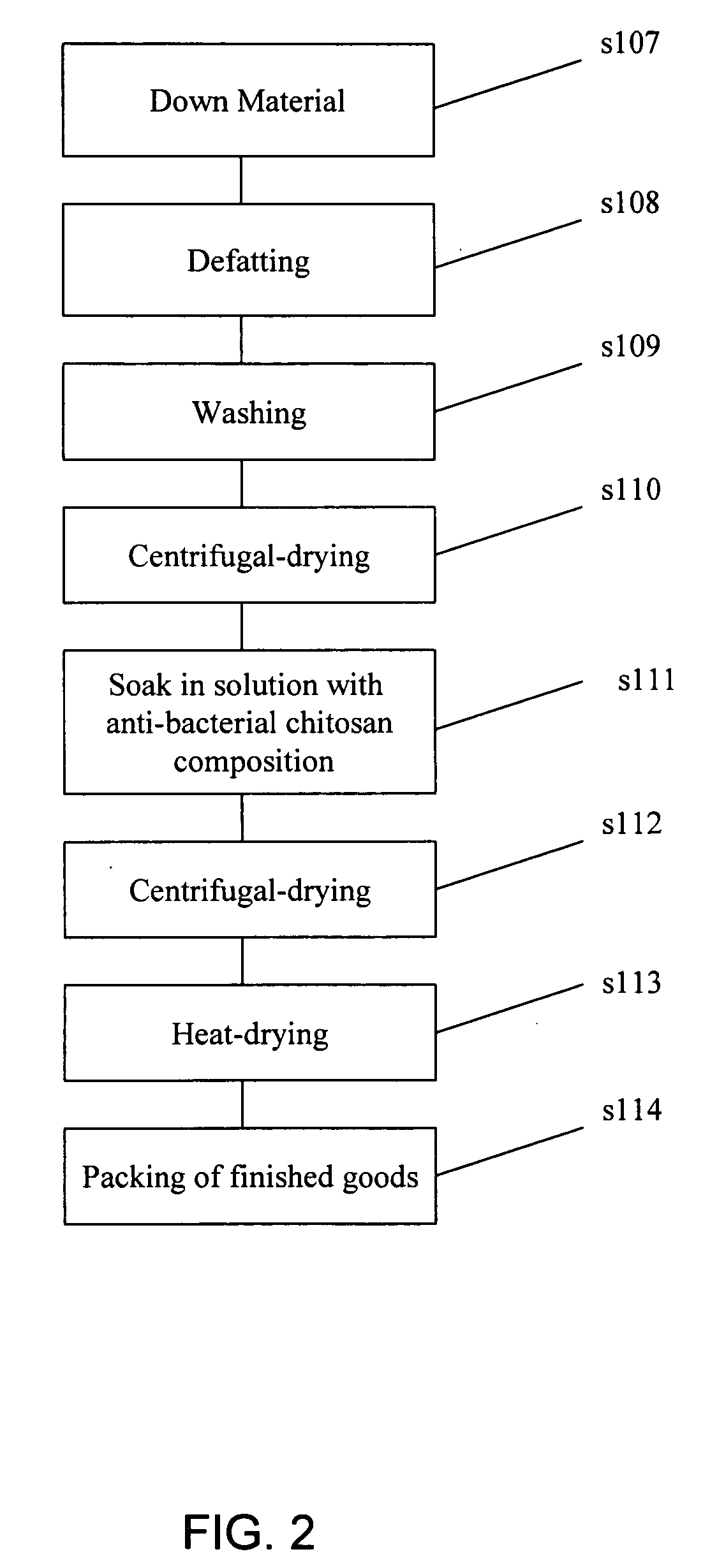Anti-microbial chitosan composition for textile products
a technology of textile products and chitosan, applied in the field of anti-microbial fabrics and textile products, can solve the problems of high toxic or otherwise undesirable by-products, undesirable residues in the final product, and product less effective in the intended us
- Summary
- Abstract
- Description
- Claims
- Application Information
AI Technical Summary
Benefits of technology
Problems solved by technology
Method used
Image
Examples
example 1
Process for Producing an Anti-microbial Chitosan Composition
[0062] The process as illustrated in FIG. 1 is described herein. Raw material comprising chitin, chitosan and cellulose is equally divided into three parts which are respectively added into acetic acid solution, as illustrated by step s101. The three solutions are kept at 70-80° C., 40-50° C. and 20-25° C. for 5-10 hours, 45-50 hours, and 95-100 hours, respectively. Afterwards, an amino-alcohol derivative and a cationic surfactant are added, as shown by step s102. Then, the three batches of chitosan acetic acid solutions are mixed, stirred fully (step s103), filtered (step s104) and stewed for 20-25 hours (step s105). They are then aged for 40-50 hours in an incubator (step s106). Finally, a non-covalently linked anti-microbial composition comprising chitin, chitosan and cellulose (a “finishing agent”) is produced in solution.
example 2
Anti-Microbial Effect in Textile Products
[0063] Down and feather treated with the anti-microbial chitosan composition of the invention were tested to show the fill power, i.e., the specific volume, of treated down. The results are depicted in Table 1.
TABLE 1Fill Power of Treated TextileFilling Power670.0 cubic inch per ozTurbidity1000.0 mmOxygen Number1.69 mgMesophilic Aerobic Bacteria Count4.7 × 104 cfu / gFaecal Streptococci CountSulphite Reducing Clostridium CountPresence of Salmonellanot found in 20 Grams
[0064] Down and feather treated with the anti-microbial chitosan composition of the invention were tested (method ASTM E 2149) to demonstrate the anti-bacterial effect on Staphylococcus aureus (ATCC 6538) and Klebsiella pneumoniae (ATCC 4352).
[0065] Test method ASTM E 2149 is designed to evaluate the resistance of non-leaching anti-microbial treated specimens to the growth of microbes under dynamic contact conditions. This dynamic shake flask test was developed for routine qua...
example 3
Anti-Microbial Effect in Textile Products
[0072] Down and feather treated with the anti-microbial chitosan composition of the invention were tested (method ASTM E 2149) for determination of anti-microbial activity of immobilized anti-microbial agents under dynamic growth conditions. The results are depicted in Table 8.
TABLE 8Klebsiella pneumoniae and Staphylococcus aureusin Treated TextileCounts (CFU / g)Sample ID(ATCC 4352)(ATCC 6538)Counts of treated substrate6.0 × 1021.3 × 103after 1 hr contact time (A)Counts of “0” contact time3.2 × 1052.3 × 103for treated substrate (B)Counts of inoculum control1.7 × 1071.9 × 106only after 1 hr contact time(C)Counts of untreated3.0 × 1051.8 × 106substrate after 1 hr contacttime (D)
Reduction, % (CFU / ml), for KP = 99.8%, for SA = 99.9%
Death Rate Constant (mean log10 density), for KP = 2.7, for SA = 3.2
PUM
| Property | Measurement | Unit |
|---|---|---|
| temperature | aaaaa | aaaaa |
| temperature | aaaaa | aaaaa |
| temperature | aaaaa | aaaaa |
Abstract
Description
Claims
Application Information
 Login to View More
Login to View More - R&D
- Intellectual Property
- Life Sciences
- Materials
- Tech Scout
- Unparalleled Data Quality
- Higher Quality Content
- 60% Fewer Hallucinations
Browse by: Latest US Patents, China's latest patents, Technical Efficacy Thesaurus, Application Domain, Technology Topic, Popular Technical Reports.
© 2025 PatSnap. All rights reserved.Legal|Privacy policy|Modern Slavery Act Transparency Statement|Sitemap|About US| Contact US: help@patsnap.com



